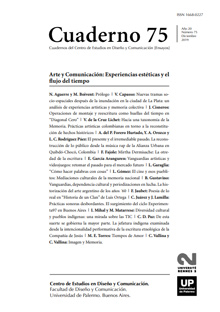El cine y esos pueblitos: Mediaciones culturales de la memoria nacional
Abstract
Roberto Arlt in 1933 publishes two short articles in the newspaper El Mundo. “The cinema and those small towns” where it tells the story of young girls from the interior who see in the film stories the hope of social uplift that they portray in the city of Buenos Aires; and “The cinema and its unemployed” where it proposes that those days of cinema continued in the cinemas of the streets La Valle and Florida, shelter social beings that on the screens find the possibility of imagining a better future in the midst of the 30’s crisis. What´s happend today with those worlds, images and peoples? Answering this question necessarily insvites us to consider, on the one hand, the revaluation of the role of the State in the cultural construction of a people; and on the other, the discussion about the national from the diverse audiovisual narratives that have arisen in recent times.
References
Almada, S. (2017). El mono en el remolino. Notas del rodaje de Zama de Lucrecia Martel. Buenos Aires, Argentina. Ed. Random House.
Argumedo, A citado en, Tabarozzi, M. (2016). Crisis de la conciencia. La aparición del pueblo en cuatro filmes del cine moderno argentino (1959-1988). Tesis de Maestría en Estética y Teoría de las Artes. FBA UNLP. Recuperado de: SEDICI - UNLP.
Didi-Huberman, G. (2014). Pueblos expuestos, pueblos figurantes. Buenos Aires, Argentina. Ed. Manantial.
Di Benedetto, A. (2017). Zama. Buenos Aires, Argentina. Ed. Adriana Hidalgo.
Fontana, P. (2009). Arlt va al cine. Buenos Aires, Argentina. Ed. Libraria.
González, D. y Nicolosi, P. (2017). “La televisión Universitaria”. En: Transiciones de la escena audiovisual. Perspectivas y disputas. Quilmes, Argentina. Ed. UNQ. 2017.
Metzman, M. y Varela, M. (2014). Masas, pueblo, multitud en cine y televisión. Buenos Aires, Argentina. Ed. Eudeba.
Tabarozzi, M. (2016). Crisis de la conciencia. La aparición del pueblo en cuatro filmes del cine moderno argentino (1959-1988). Tesis de Maestría en Estética y Teoría de las Artes. FBA UNLP. Recuperado de: SEDICI - UNLP.
Vallina, C. (2016). El tercer relato. La Plata, Argentina. Ed. Edulp
Filmografía videografía
Caetano, A. y Stagnaro, B. (1998). Pizza Birra Faso. Argentina.
Caetano, A. (2001). Bolivia. Argentina.
Caetano, A. (2002). Un oso Rojo. ArgentIna.
Caetano, A. (2017). El otro hermano. Argentina.
Stagnaro, B. (2017). Un Gallo para Esculapio. Argentina.
Favio, L. (2008). Aniceto. Argentina.
Favio, L. (1960). El amigo. Argentina.
Favio, L. (1967). El romance del Aniceto y la Francisca de cómo quedó trunco y algunas cosas más. Argentina.
Martel, L. (2017). Zama. Argentina.
Rebella, P. y Stoll, P. (2001) 25 watt. Uruguay.
Los autores/as que publiquen en esta revista ceden los derechos de autor y de publicación a "Cuadernos del Centro de Estudios de Diseño y Comunicación", Aceptando el registro de su trabajo bajo una licencia de atribución de Creative Commons, que permite a terceros utilizar lo publicado siempre que de el crédito pertinente a los autores y a esta revista.


